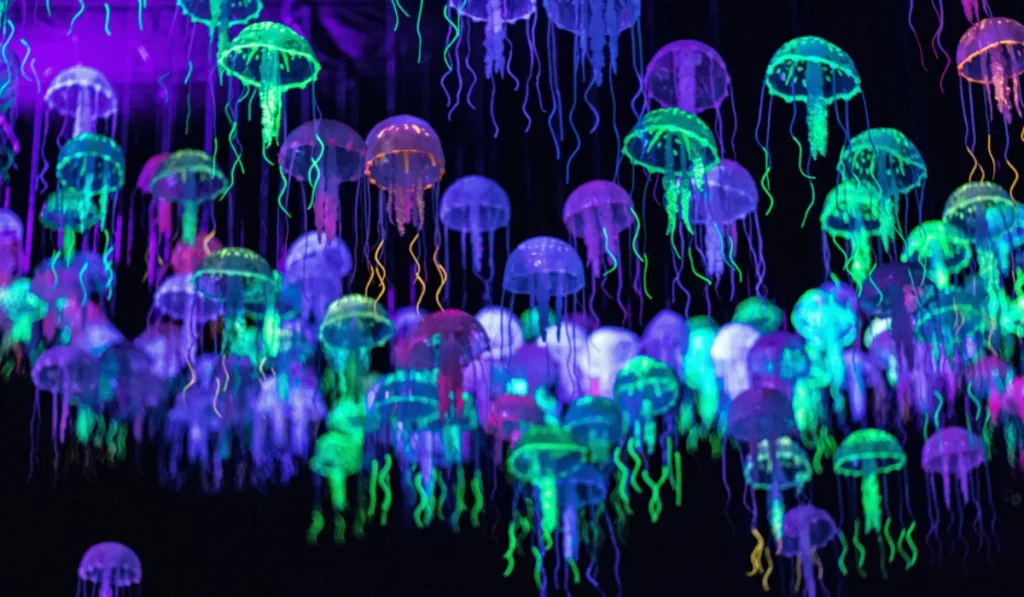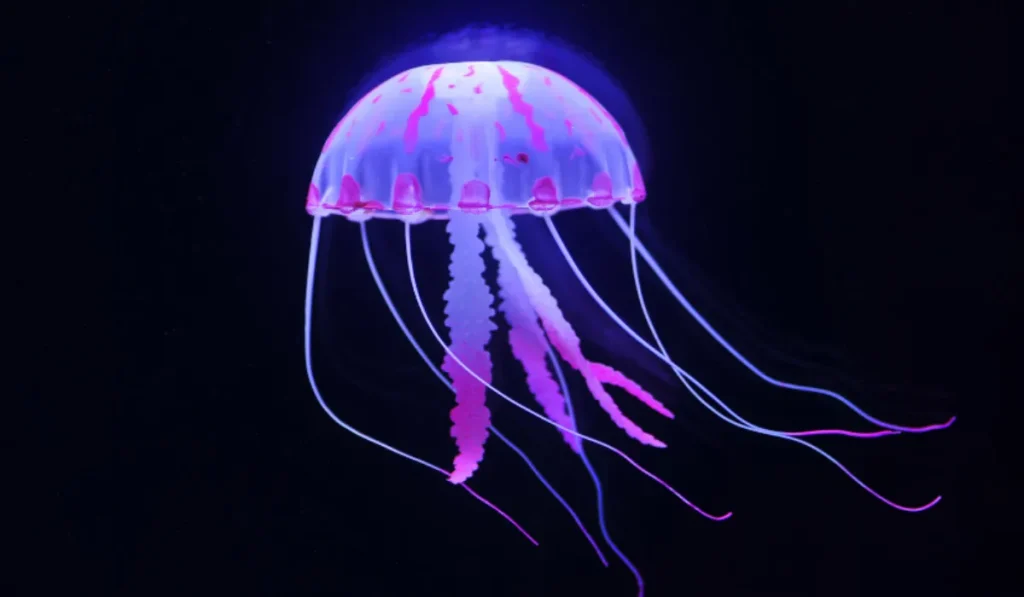A jellyfish’s weight varies widely, typically ranging from less than an ounce to 400 pounds. The variation depends on the species and size of the jellyfish.
Exploring the world of jellyfish reveals an array of species, each with unique characteristics and sizes.
From the petite, almost invisible specimens to the massive Lion’s Mane jellyfish, their weight can be as minimal as a few grams or as hefty as a couple hundred kilograms.
Diving into the underwater realms, these fascinating creatures exhibit a simplicity in their gelatinous bodies, comprising mostly of water.
This composition significantly affects their weight, which is quite less compared to their volume. Recognizing the diversity among the thousands of jellyfish species is crucial for understanding the broad range of how much they might weigh.
Marine biologists and ocean enthusiasts alike are captivated by the ethereal nature of jellyfish, making them a subject of continuous study and fascination.
The Mystique Of Jellyfish
The jellyfish, an enigma of the ocean, captures our imagination with its graceful, pulsing movements and ghostly form.
This creature’s delicate appearance belies its survival through ages, floating in our world’s seas.
A question often posed is: How much does a jellyfish weigh? To understand this, let’s plunge into the depths of their existence and explore their weight in the vastness of the ocean.
Ancient Swimmers Of The Sea
Jellyfish have been around for over 500 million years, making them some of the oldest swimmers in the sea.
These ancient beings have seen dinosaurs come and go, surviving mass extinctions and climatic shifts.
They owe their longevity to their simple yet effective body designs and lifecycles. Even without brains or hearts, jellyfish continue to thrive in oceans across the globe.
Diversity In Size And Form
There is no single answer to a jellyfish’s weight because they vary so much. Some species are as light as a feather, while others are as heavy as a grown person. To illustrate, let’s look at some examples:
| Jellyfish Type | Average Weight |
|---|---|
| Lion’s Mane | Up to 200 kg |
| Moon Jellyfish | About 20 g |
| Portuguese Man O’War | Less than 50 g |
These creatures range in size from tiny, almost invisible juveniles to gigantic, awe-inspiring adults.
Some span less than an inch, while others like the Nomura’s jellyfish can grow to the size of a human adult. This remarkable size variation alludes to their adaptability and the diverse roles they play in marine ecosystems.
Weighing A Watery Wonder

The graceful jellyfish, with its pulsating bell and trailing tentacles, presents a fascinating enigma for marine biologists and ocean lovers alike.
Jellyfish float through the seas with an almost ethereal quality, their forms ranging from minuscule to majestic.
Understanding their weight offers insight into their role in ocean ecosystems.
The Challenge Of Measuring
Jellyfish are notoriously difficult to weigh accurately.
They consist primarily of water, which presents unique challenges when assessing their mass.
- They may lose water and change weight outside their habitat.
- Measuring methods must consider their delicate structures.
Average Weights Across Species
Jellyfish species vary widely in size, shape, and weight.
| Species | Average Weight |
|---|---|
| Moon Jellyfish | 20 grams |
| Lion’s Mane Jellyfish | Up to 200 kg |
| Portuguese Man O’ War | Around 12 ounces |
This table offers a glimpse at the diverse sizes of these marine creatures.
From tiny to tremendous, jellyfish showcase the ocean’s vast tapestry of life.
Size Matters In The Ocean

Under the waves, size plays a crucial role for sea creatures. In the jellyfish family, weights range from the feather-light to the truly colossal.
The ocean is home to a vast variety of jellyfish, each with their unique characteristics. Some jellyfish you might not even feel if they brush against you, while others demand respect with their size alone.
From Tiny To Titanic
Jellyfish come in an array of sizes. Each species has evolved to find its perfect place in the marine ecosystem. The lightest jellyfish float around almost invisible, while the heavier ones can be likened to the ocean’s living parachutes.
- Small jellyfish often weigh less than 1 ounce (28 grams).
- Medium-sized species may weigh up to a few pounds.
- The weight of large jellyfish can surprise you. They can tip the scales at more than 20 pounds (9 kilograms).
The Giants Of The Jellyfish World
The gigantic jellyfish awe both scientists and swimmers alike. They are the heavyweights of the jellyfish family.
| Jellyfish Species | Average Weight |
|---|---|
| Lion’s Mane Jellyfish | Up to 200 pounds (90 kg) |
| Nomura’s Jellyfish | Up to 440 pounds (200 kg) |
These titans can have tentacles that stretch as long as a blue whale. Lion’s Mane and Nomura’s Jellyfish take the crown for not just weight, but also for their size. Their massive presence serves as a clear reminder—size matters in the ocean.
Understanding The Jellyfish Structure
Have you ever wondered about the weight of a jellyfish? Unlike land animals, jellyfish have a unique composition. They float effortlessly through oceans. Let’s dive into the physical structure of jellyfish to understand why.
Composed Mostly Of Water
Jellyfish are fascinating creatures with bodies made up of 95% water. This high water content gives them their gelatinous texture and light weight. Interestingly, when removed from water, a jellyfish will lose most of its mass and practically melt away into a puddle of liquid.
This fact indicates that the water in their bodies plays a crucial role in their weight and structure.
- Minimal solid matter: Jellyfish possess a simple body plan.
- Gelatinous structure: It allows them to float with ocean currents.
- Different species, different sizes: Sizes range from a few millimeters to 2 meters!
The Role Of Tentacles In Weight
Jellyfish tentacles are pivotal for hunting and defense. But they also contribute to the overall weight of the jellyfish, albeit slightly.
Tentacles are lined with nematocysts: these are stinging cells that help capture prey.
| Tentacle Feature | Description | Weight Contribution |
|---|---|---|
| Nematocysts | Microscopic stinging structures | Minimal |
| Length | Varies greatly among species | Proportional to size |
| Quantity | Can range from a few to hundreds | Varies but remains slight |
The heavier the tentacle, the larger the jellyfish: This is often the case, though the weight is still marginal compared to the jellyfish’s high water content.
Jellyfish In Human Culture And Science
The mysterious and enchanting jellyfish not only drifts through the depths of our oceans but also floats through various aspects of human culture and science.
While it might be challenging to imagine, these delicate creatures have weaved their way into our lives in more ways than one might expect. From tantalizing taste buds to inspiring scientific research, jellyfish hold a unique position in human experience.
Culinary Delicacies And Jellyfish
Jellyfish have long been a part of culinary traditions in many coastal communities. With their unique texture and flavor, these marine creatures have turned into a sought-after dish. Below, find fascinating facts about jellyfish as a delicacy:
- Dried and salted for preservation
- Often served in Asian cuisine, especially Japanese, Korean, and Chinese
- Considered a source of collagen, touted for health benefits
- Typically prepared as a cold, seasoned salad
Jellyfish dishes vary in weight, ranging from light appetizers to more substantial servings. Their weight in the kitchen is usually much less than their weight in the wild, due to processing.
Research And The Value Of Jellyfish Studies
Scientists have long been intrigued by jellyfish, leading to valuable research in various fields. Let’s delve into how these studies benefit our understanding:
| Research Area | Benefits |
|---|---|
| Ecosystem Impact | Helps predict and manage jellyfish blooms |
| Medical Applications | Contributes to advancements in drug delivery and tissue engineering |
| Evolutionary Biology | Sheds light on the evolutionary history of multicellular organisms |
Research also includes studying jellyfish weights for understanding their life cycle and health. The weight of jellyfish serves as an important metric in marine biology studies, impacting our broader knowledge of oceanic ecosystems.
FAQs About the Weight of A Jellyfish
What Is The Average Weight Of A Jellyfish?
Jellyfish species vary greatly in size, thus their weight can differ. On average, smaller jellyfish may weigh a few grams while larger species like the lion’s mane can exceed 200 pounds.
Can A Jellyfish Weigh Over 100 Pounds?
Yes, some jellyfish can weigh over 100 pounds. The lion’s mane jellyfish, for instance, can weigh as much as 200 pounds or more, depending on its size and age.
How Much Do Common Jellyfish Species Weigh?
Common jellyfish species like the moon jellyfish typically weigh about 2 to 3 pounds. Heavier species exist, but these are less commonly encountered by the average beachgoer.
Does The Weight Of A Jellyfish Affect Its Sting?
The weight of a jellyfish is not directly related to the potency of its sting. Jellyfish stings depend on the species and the size and concentration of their nematocysts, not their overall weight.
Conclusion
Understanding jellyfish weight varies widely, influenced by species and environment. This fascinating undersea topic reveals nature’s complexity and diversity. Always approach marine life responsibly. Remember, every creature, regardless of size, plays a vital role in our oceans’ ecosystems. Keep exploring the wonders beneath the waves!
Resources:
https://floridakeys.noaa.gov/animals/whatrjellies.html
https://oceanservice.noaa.gov/facts/jellyfish.html
